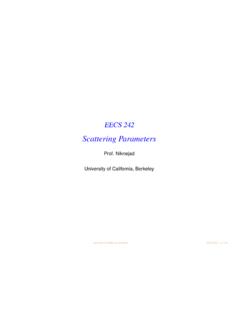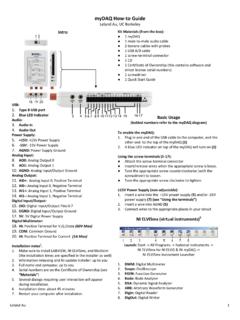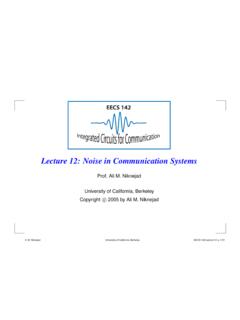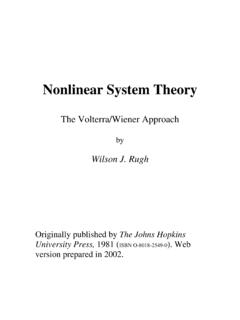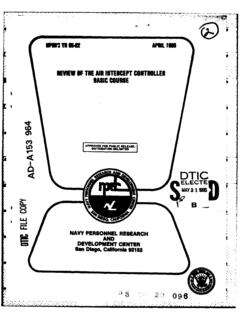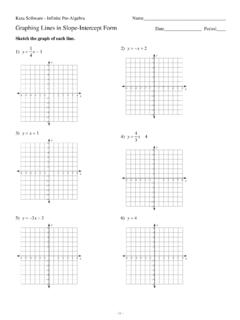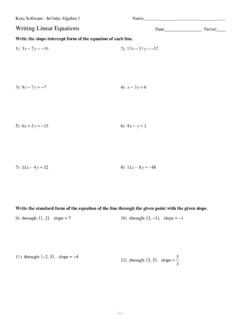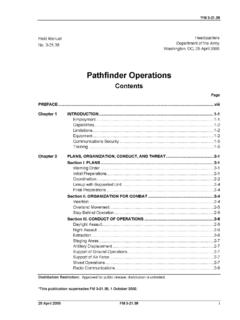Transcription of Lecture 9: Intercept Point, Gain Compression and Blocking
1 EECS 142 Lecture 9: Intercept Point, gain Compression andBlockingProf. Ali M. NiknejadUniversity of California, BerkeleyCopyrightc 2005 by Ali M. NiknejadA. M. NiknejadUniversity of California, BerkeleyEECS 142 Lecture 9 p. 1/29 p. 1/29 gain CompressionViVodVodViViVodVodViThe large signal input/output relation can display gaincompression or expansion. Physically, most amplifierexperience gain Compression for large small-signal gain is related to the slope at a givenpoint. For the graph on the left, the gain decreases forincreasing M. NiknejadUniversity of California, BerkeleyEECS 142 Lecture 9 p. 2/29 p. 2/291 dBCompression Point VoVi ViPo, 1dBPi, 1dBGain Compression occurs because eventually theoutput signal (voltage, current, power) limits, due to thesupply voltage or bias we plot the gain (log scale) as a function of the inputpower, we identify the point where the gain has droppedby1 dB.
2 This is the1 dBcompression point. It s a veryimportant number to keep in M. NiknejadUniversity of California, BerkeleyEECS 142 Lecture 9 p. 3/29 p. 3/29 Apparent GainRecall that around a small deviation, the large signalcurve is described by a polynomialso=a1si+a2s2i+a3s3i+ For an inputsi=S1cos( 1t), the cubic term generatesS31cos3( 1t) =S31cos( 1t)12(1 + cos(2 1t))=S31(12cos( 1t) +24cos( 1t) cos(2 1t))Recall that2 cosacosb= cos(a+b) + cos(a b)=S31(12cos( 1t) +14(cos( 1t) + cos(3 1t)))A. M. NiknejadUniversity of California, BerkeleyEECS 142 Lecture 9 p. 4/29 p. 4/29 Apparent gain (cont)Collecting terms=S31(34cos( 1t) +14cos(3 1t))The apparent gain of the system is thereforG=So, 1Si, 1=a1S1+34a3S31S1=a1+34a3S21=a1(1 +34a3a1S21)=G(S1)Ifa3/a1<0, the gain compresses with M.
3 NiknejadUniversity of California, BerkeleyEECS 142 Lecture 9 p. 5/29 p. 5/291-dB Compression PointLet s find the input level where the gain has dropped by1 dB20 log(1 +34a3a1S21)= 1 dB34a3a1S21= 43 a1a3 =IIP3 dBThe term in the square root is called the third-orderintercept point (see next few slides).A. M. NiknejadUniversity of California, BerkeleyEECS 142 Lecture 9 p. 6/29 p. 6/29 Intercept PointIP2-50-40-30-20-10-40-30-20-100dBcI P2 Pin(dBm)Pout(dBm)IIP2 OIP2dBc102010 Fund2ndThe extrapolated point whereIM2= 0 dBcis known asthe second order Intercept M. NiknejadUniversity of California, BerkeleyEECS 142 Lecture 9 p. 7/29 p. 7/29 Properties of Intercept PointIP2 Since the second order IM distortion products increaselikes2i, we expect that at some power level the distortionproducts will overtake the fundamental extrapolated point where the curves of thefundamental signal and second order distortion productsignal meet is the Intercept Point (IP2).
4 At this point, then, by definitionIM2= 0 input power level is known asIIP2, and the outputpower when this occurs is theIP2point is known, theIM2at any otherpower level can be calculated. Note that for adBback-off from theIP2point, theIM2improvesdBfordBA. M. NiknejadUniversity of California, BerkeleyEECS 142 Lecture 9 p. 8/29 p. 8/29 Intercept PointIP3-50-40-30-20-10-30-20-10 010dBcIP3 Pin(dBm)Pout(dBm)IIP3 OIP3dBc20 FundThirdThe extrapolated point whereIM3= 0 dBcis known asthe third-order Intercept M. NiknejadUniversity of California, BerkeleyEECS 142 Lecture 9 p. 9/29 p. 9/29 Properties of Intercept PointIP3 Since the third order IM distortion products increase likes3i, we expect that at some power level the distortionproducts will overtake the fundamental extrapolated point where the curves of thefundamental signal and third order distortion productsignal meet is the Intercept Point (IP3).
5 At this point, then, by definitionIM3= 0 input power level is known asIIP3, and the outputpower when this occurs is theIP3point is known, theIM3at any otherpower level can be calculated. Note that for a10 dBback-off from theIP3point, theIM3improves20 M. NiknejadUniversity of California, BerkeleyEECS 142 Lecture 9 p. 10/29 p. 10/29 Intercept Point ExampleFrom the previous graph we see that our amplifier hasanIIP3= 10 s theIM3for an input power ofPin= 20 dBm?Since theIM3improves by20 dBfor every10 dBback-off, it s clear thatIM3= 20 dBcWhat s theIM3for an input power ofPin= 110 dBm?Since theIM3improves by20 dBfor every10 dBback-off, it s clear thatIM3= 200 dBcA. M. NiknejadUniversity of California, BerkeleyEECS 142 Lecture 9 p.
6 11/29 p. 11/29 CalculatedIIP2/IIP3We can also calculate theIIPpoints directly from ourpower series expansion. By definition, theIIP2pointoccurs whenIM2= 1 =a2a1 SiSolving for the input signal levelIIP2=Si=a1a2In a like manner, we can calculateIIP3IM3= 1 =34a3a1S2iIIP3=Si= 43 a1a3 A. M. NiknejadUniversity of California, BerkeleyEECS 142 Lecture 9 p. 12/29 p. 12/29 Blocker or JammerSignalInterferencechannelLNAC onsider the input spectrum of a weak desired signaland a blocker Si=S1cos 1t Blocker+s2cos 2t DesiredWe shall show that in the presence of a stronginterferer, the gain of the system for the desired signalis reduced. This is true even if the interference signal isat a substantially difference frequency.
7 We call thisinterference signal a jammer .A. M. NiknejadUniversity of California, BerkeleyEECS 142 Lecture 9 p. 13/29 p. 13/29 Blocker (II)Obviously, the linear terms do not create any kind ofdesensitization. The second order terms, likewise,generate second harmonic and intermodulation, but notany fundamental particular, the cubic terma3S3igenerates the jammerdesensitization termS3i=S31cos3 1t+s32cos3 2t+ 3S21s2cos2 1tcos 2t+3s21S2cos2 2tcos 1tThe first two terms generate cubic and third last two terms generate fundamental signals at 1and 2. The last term is much smaller, though, sinces2 M. NiknejadUniversity of California, BerkeleyEECS 142 Lecture 9 p. 14/29 p. 14/29 Blocker (III)The blocker term is therefore given bya33S21s212cos 2tThis term adds orsubtractsfrom the desired <0for most systems (compressivenon-linearity), the effect of the blocker is to reduce thegainApp gain =a1s2+a332S21s2s2=a1+a332S21=a1(1 +32a3a1S21)A.
8 M. NiknejadUniversity of California, BerkeleyEECS 142 Lecture 9 p. 15/29 p. 15/29 Out of Band3 dBDesensitizationLet s find the blocker power necessary to desensitizethe amplifier by3 dB. Solving the above equation20 log(1 +32a3a1S21)= 3 dBWe find that the blocker power is given byPOB=P 1dB+ dBIt s now clear that we should avoid operating ouramplifier with any signals in the vicinity ofP 1dB, sincegain reduction occurs if the signals are larger. At thissignal level there is also considerable M. NiknejadUniversity of California, BerkeleyEECS 142 Lecture 9 p. 16/29 p. 16/29 Series InversionOften it s easier to find a power series relation for theinput in terms of the output.
9 In other wordsSi=a1So+a2S2o+a3S3o+ But we desire the inverse relationSo=b1Si+b2S2i+b3S3i+ To find the inverse relation, we can substitute the aboveequation into the original equation and equatecoefficient of like (b1Si+b2S2i+b3S3i+ ) +a2( )2+a3( )3+ A. M. NiknejadUniversity of California, BerkeleyEECS 142 Lecture 9 p. 17/29 p. 17/29 Inversion (cont)Equating linear terms, we find, as expected, thata1b1= 1, orb1= 1 the square terms, we have0 =a1b2+a2b21b2= a2b21a1= a2a31 Finally, equating the cubic terms we have0 =a1b3+a22b1b2+a3b31b3=2a22a51 a3a41It s interesting to note that if one power series does nothave cubic,a3 0, the inverse series has cubic due tothe first term M.
10 NiknejadUniversity of California, BerkeleyEECS 142 Lecture 9 p. 18/29 p. 18/29 CascadeIIP2 AIIP3 AIIP2 BIIP3 BIIP2 IIP3 GAVGAPA nother common situation is that we cascade twonon-linear systems, as shown above. we havey=f(x) =a1x+a2x2+a3x3+ z=g(y) =b1y+b2y2+b3y3+ We d like to find the overall relationz=c1x+c2x2+c3x3+ A. M. NiknejadUniversity of California, BerkeleyEECS 142 Lecture 9 p. 19/29 p. 19/29 Cascade Power SeriesTo findc1,c2, , we simply substitute one power seriesinto the other and collect like linear terms, as expected, are given byc1=b1a1=a1b1 The square terms are given byc2=b1a2+b2a21 The first term is simply the second order distortionproduced by the first amplifier and amplified by thesecond amplifier linear term.
